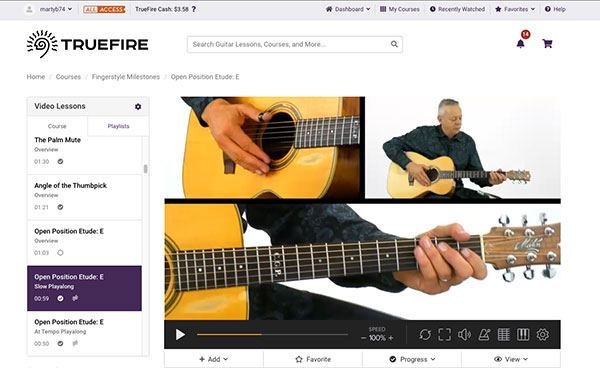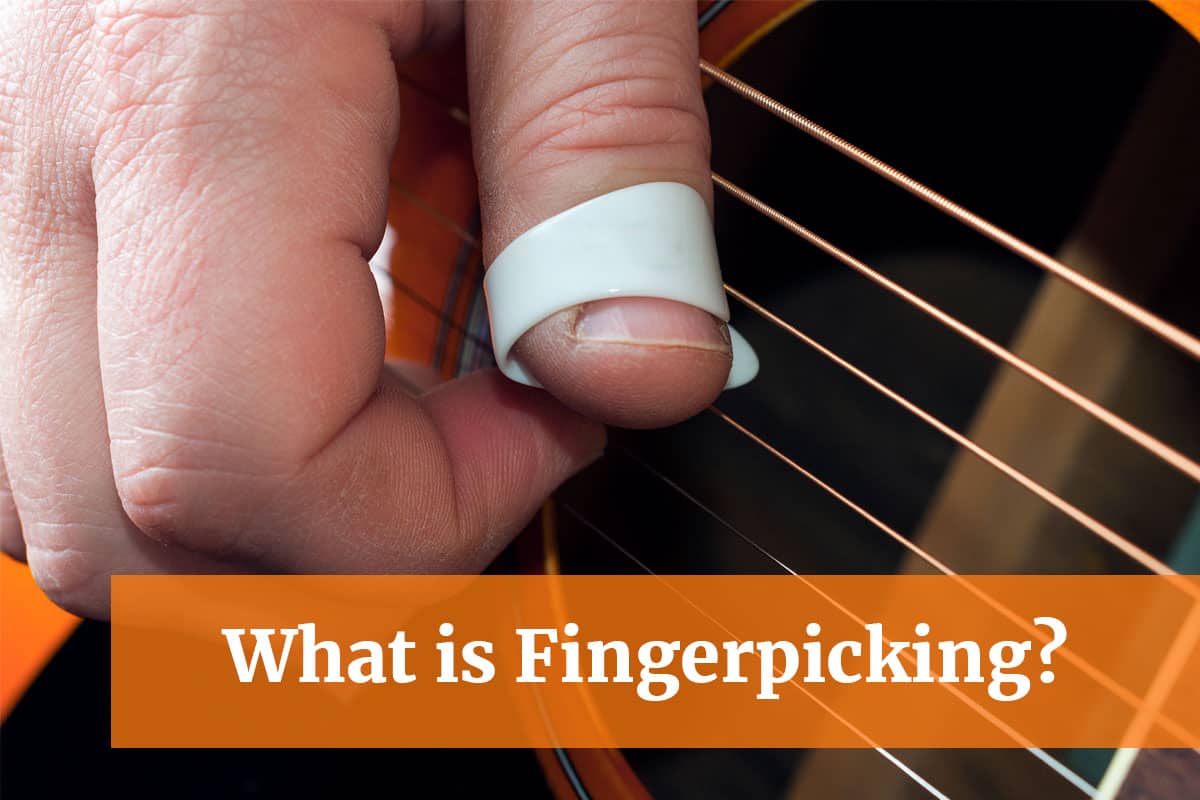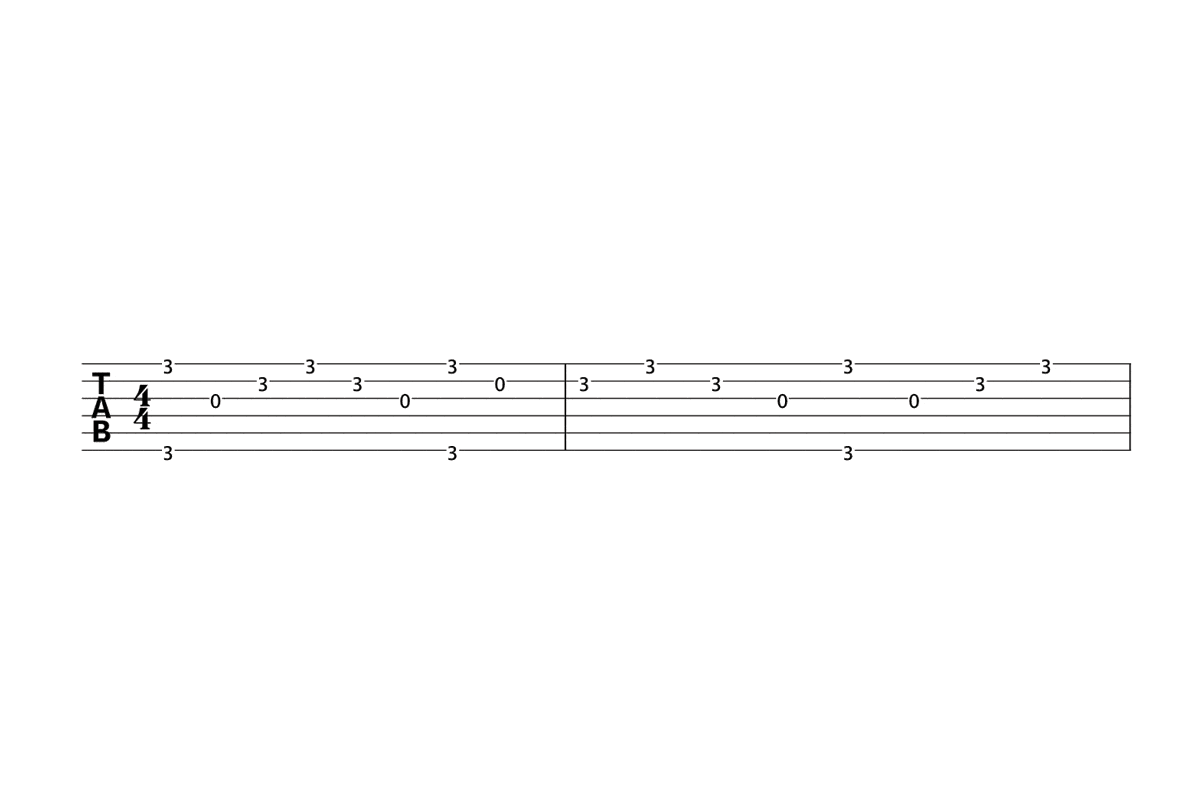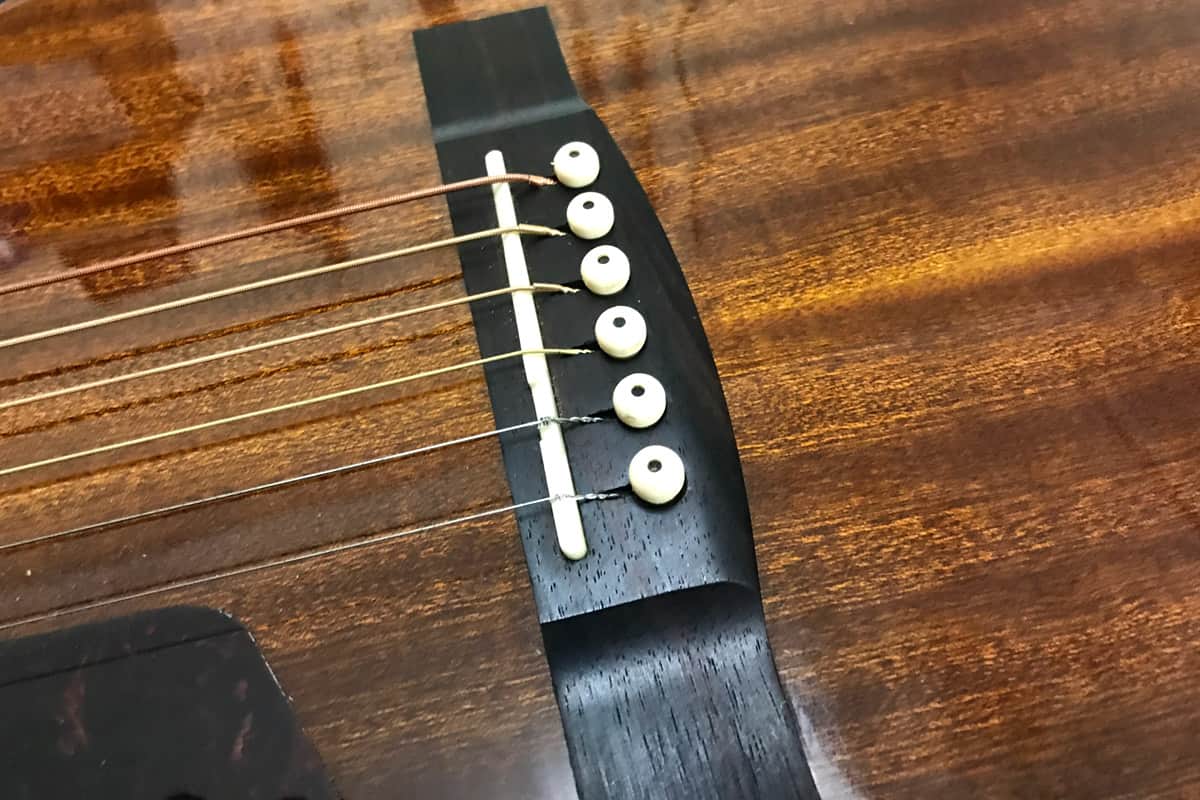Fingerpicking involves playing a constant alternating 4/4 bass pattern on the lower three strings with the thumb while playing rhythm and syncopated melody on the top three strings using the index, ring, and middle finger. Due to the focus on thumb and finger independence rhythm and melody are played simultaneously giving the impression more than one guitar is being played.
While not played using a traditional flat pick, many fingerpickers also use thumb picks, worn on the thumb, attached by a pinch band with the ‘pick’ protruding out toward the guitar’s strings (as shown below) so the guitarist can play with the thumb parallel to the stings.

Some guitar players who play in this style also use fingerpicks worn on the tips of the fingers, while many use just the flesh of the thumb and fingers.
In the following guide and ensuing series of articles, we’ll be going in-depth on fingerpicking, including how to get started, the benefits of learning this approach to the guitar, and the terminology associated with it. We’ll also showcase the most influential artists who play in this style. So if you are interested in learning more about fingerpicking, stay tuned!
What’s the difference between fingerstyle and fingerpicking Guitar?
There’s no right or wrong answer when it comes to the differences between fingerstyle and fingerpicking. In fact, for many, there is no discernible difference at all.
Both terms, historically have been used interchangeably and mean different things to different people.
In my experience, the term fingerstyle guitar playing describes an all-encompassing, polyphonic approach (two or more lines of melody) to playing the guitar, predominantly with the fingers, and includes guitarists such as James Taylor, Paul Simon, Jimmy Page, Bob Dylan, Lindsey Buckingham, and Joni Mitchell to name just a few of many.
In the broader sense, fingerstyle playing is an important component of flamenco and classical guitar technique, folk music, and jazz, incorporated by legendary guitarists such as Eddie Lang, and Lonnie Johnson.
It’s also a style used by traditional blues slide guitarists, such as Robert Johnson, ragtime guitarists such as Blind Blake, and American primitive guitar players such as John Fahey.
Is also central to modern percussive fingerstyle guitar, a style of playing that incorporates the palm and fingers percussively on the guitar body (played like a bass drum) and strings (snare), employed by artists such as Mike Dawes, Antoine Dufour, Jon Gomm, and Andy Mckee.
In simple terms, fingerstyle can be thought of as an approach to playing the guitar where the fingers and thumb play individual notes, without a traditional flat pick. For example, classical guitarists play fingerstyle, as they never use traditional flat picks.
Fingerpicking could be considered a subset of fingerstyle guitar, primarily played on steel-string guitars. However, as mentioned above both terms mean different things to different people.
What is Travis Picking
Travis picking is a solo guitar playing style brought to prominence by the great American country music songwriter and guitar player Merle Travis.
It’s an unaccompanied guitar style, thought to have been heavily influenced by honky-tonk piano. In particular, the constant driving rhythm played with the left hand on the piano is transferred to the thumb on the guitar and used to provide the bass notes while the remaining fingers play the accompaniment on the treble strings, on the beat, and/or syncopated e.g. between the bass notes.
The strings are also partially muted giving the guitar the familiar “boom chick” sound synonymous with Travis Picking. (more on this shortly)
Alternating Bass Style
In this guide and series of articles, we’ll be discussing fingerpicking as an approach to the guitar that uses the thumb to play alternating patterns on the bass strings while the remaining fingers play accompaniment, in the style of Merle Travis.
But don’t get too hung up on the terminology, it matters little, as you will hear both terms used interchangeably. And even in the strictest sense, there is a lot of overlap, both technically and culturally.
Why Learn Fingerpicking?
The real advantage of fingerpicking as opposed to using a flat pick is the complex sound produced e.g. the ability to play multiple parts simultaneously, due to the focus on finger and thumb independence this approach to the guitar provides.
One of the best explanations of this I’ve heard is from Tommy Emmanuel (arguably the greatest finger-picker alive today) in a highly entertaining TEDx talk back in 2014.
As the great man explains, fingerpicking allows him to approach the guitar like a one-man-band, rather than a solo musician.
The thumb provides the bass line, the palm (and fingers) provide percussion, while the remaining fingers provide the rhythm and melody. And despite Tommy, playing unaccompanied guitar, his performances sound anything but sparse, as evidenced by his remarkable live shows and recorded music, including one of my personal favorites “Lewis & Clark”.
Check out the song above, (things get going around the 1 min mark), and then stop to remind yourself it’s a live performance, just Tommy and his trusty Maton, no percussion, or additional instrumentation required.
Equipment for Fingerpicking
Do you need to use a thumb pick?
Many fingerstyle players prefer to use a thumb pick as this can provide a more balanced output from the guitar as the thumb pick allows greater volume and projection of the bass strings, allowing them to compete with the treble strings.
Best Strings for Fingerpicking
The heavier the gauge of string you use, the more volume you will generate from the guitar, but the guitar will be more difficult to play due to the additional tension heavier strings provide.
Most guitarists start playing fingerstyle using light to medium gauge strings e.g. 12s before progressing on to heavier gauge strings once they develop the necessary hand strength. For the most part, this is subjective and comes down to personal preference.
Best Guitars for Fingerpicking
I’ve written a complete article here on the best guitars for fingerpicking and fingerstyle, but much like strings, there are no hard and fast rules.
Comfort should be the priority, and it’s for this reason many finger pickers prefer a small body guitar (parlor, or concert size) as larger body guitars are less comfortable in a sitting position (which is typically the way fingerstyle and fingerpicking guitarists choose to play).
But just as many fingerstyle guitarists play dreadnoughts, especially percussive fingerstyle guitarists as this allows for a greater range of percussive options and greater resonance.
Smaller body guitars, if playing solely with the fingers are often more responsive, but again this is largely subjective so in many cases, the guitar you already have will be sufficient to get started playing in this style.
Alternative Tunings

Many guitarists fingerpick using alternate tunings. Alternate tunings offer advantages for specific styles of music that would be otherwise impossible to play in a common tuning.
Popular alternate tunings include DADGAD, double drop D, and open tunings such as open E, open G, and open A, meaning the strings are tuned to a specific open chord.
We won’t be delving into alternate tunings in this article, but if you are interested in learning more about alternate tunings I have written an introductory guide you can find here. You can also check out artists who rely heavily on alternate tunings including John Fahey, Leo Kottke, and John Hurt.
Fingerpicking Technique
Getting Started with Fingerpicking
The primary focus when learning to fingerpick is to develop thumb and finger independence. This is what allows for both rhythm and melody to be played simultaneously.
To do this successfully, the thumb and fingers are assigned specific strings to play. For example, the thumb usually plays 4 beats to the bar on the thicker bass strings (4th, 5th, and 6th strings) using downstrokes, while the index finger, middle, and ring finger play the remaining strings using upstrokes.
PIMA

Fingerstyle guitar incorporates a technique of naming each finger (using the Spanish name for the individual fingers) known as PIMA.
The fingers are assigned to specific strings e.g. P stands for pulgar (thumb) and is assigned the 4th (D), 5th (A), and 6th (E) strings.
I is for indice (index finger) and is assigned the 3rd string (G). M stands for medio (middle finger) and is assigned the 2nd string (B) and A is for anular (ring finger) which is assigned to the 1st string (E).
While it may feel unnecessarily complicated to assign specific fingers to specific strings, to begin with, favoring comfort over technical efficiency when first learning fingerpicking may cost you valuable time in the long run. As bad habits will need to be un-learned to improve your efficiency when learning more advanced material.
Of course, there are countless exceptions to this rule. Merle Travis, for example, predominantly used just his thumb and index finger, so while considered “best practice” it’s not critical to playing in this style.
What about the pinky?
The pinky is predominantly used to anchor the picking hand to the guitar. However, like the use of thumb picks, this isn’t strictly the case for all guitarists who play in this style.
Palm Muting
Another important aspect, synonymous with fingerpicking is the boom chick sound touched on earlier.
Boom chick describes the sound of fingerpicking in the style of Merle Travis. To achieve this sound, the palm partially mutes the strings by laying across the bridge. This causes the notes to decay quickly, giving this technique its unique “Boom chick” sound, boom (bass) chick (treble).
The angle of the Thumb

Regardless of whether you are wearing a thumb pick or playing with the flesh of the thumb and fingers. The thumb should be parallel to the guitar’s strings. This allows for more efficient movement.
This is especially important if wearing a thumb pick as this allows the full surface area of the pick to come into contact with the strings.
Learning Fingerpicking Patterns
To get started with fingerpicking, guitarists typically focus on the picking hand, and begin with just the thumb and the bottom 3 strings, beginning on the root note of the chord. Focusing on this early on helps develop the thumb independence required to play the constant alternating bass pattern.
Thumb Independence
In the example tab below, we can see a simple bass pattern played with the thumb across the 4th, 5th, and 6th strings of the guitar while playing a simple I – IV- V chord progression in the key of C.

While a simple pattern (at least to begin with) once proficient, the fingers are then slowly introduced, while maintaining the constant bass pattern with the thumb.
This is where things start becoming more challenging.
the Pinch Technique
The next step is to add to the chords by playing an additional note from the chord on the beat using the pinch technique (sometimes referred to as claw hammer), using your thumb and index finger (G string), or thumb and middle finger (B string), as per the example below.

Lastly, syncopation is added in the form of additional notes played on the off-beat, facilitating rhythm and melody being played simultaneously.

This is just one example of a simple fingerpicking guitar pattern, there are many patterns guitarists can play in this style.
The Best Place to Learn Fingerpicking
In my experience, it’s best to learn from the best.
And when it comes to fingerpicking there is none better than Tommy Emmanuel, whose course ‘fingerstyle milestones’ on Truefire.com is one of the best introductory resources for learning to fingerpick.

Considering the relatively inexpensive price to purchase a single course at Truefire, it’s a no-brainer to start learning fingerpicking from the master himself.
I have an all-access pass, and couldn’t be happier with the value I’ve had out of the platform, especially after trying numerous other platforms including Jamplay. Click the banner below to get started.

Important Fingerpicking Guitarists Worth Checking Out
If you are interested in seeking inspiration, while not an exhaustive list, the guitarists listed below are some of the finest exponents of fingerpicking and well worth taking the time to check out:
Merle Travis
American guitarist and songwriter Merle Travis (1917 – 1983) may not be solely responsible for inventing the alternating bass line style of fingerpicking his name is forever connected to, but he popularized it and went on to influence many of the guitarists mentioned in this article.
Notice, in the case of Merle Travis, he plays with just the thumb and index finger, using the middle, ring, and pinky to anchor his picking hand to the guitar.
Chet Atkins
Mr. Guitar, Chet Atkins (1924 – 2001) was one of the true pioneers of fingerpicking guitar. While he sadly passed away in 2001 his influence lives large, and he’s often cited by many of the great guitarists who play in a similar style today.
A 7-year-old Tommy Emmanuel upon hearing the song above (Windy and Warm) on the radio was inspired to begin playing in this style. Interestingly, the two famously went on to record music together later in Chet’s life.
Tommy Emmanuel – Arguably one of the best acoustic guitarists on the planet today, and certainly one of the finest fingerpickers to ever don a thumb pick. Proudly Australian Tommy Emmanuel has enjoyed a long and distinguished career predominantly on the acoustic guitar and almost exclusively playing that ‘boom chick’ style of fingerpicking.
Here’s a clip of Tommy playing a song called “Son of a Gun” written by Tommy and dedicated to Thom Bresh, Merle Travis’s son, also a fine fingerpicker in his own right.
Mark Knopfler – While many will be familiar with Knopfler’s work on the electric guitar in Dire Straits, Mark Knopfler is an incredibly versatile musician, and one of the truly great fingerstyle guitarists alive today. Like Tommy Emmanuel, he’s another guitarist heavily influenced by the great Chet Atkins, equally at home fingerpicking on acoustic guitar as delivering iconic guitar lines on his Strat.
Here’s a clip of Mark Knopfler explaining his journey from strumming to fingerpicking.
Fingerpicking Songs
There are a number of classic fingerpicking songs, below is a small selection of some of the most iconic.
Freight train – Mary Cotton
There are several ‘staples’ when it comes to learning to fingerpick, none more so than the classic “Freight Train’ by Mary Cotton, a left-handed acoustic guitarist who played a right-handed guitar upside down!
Freight train is simply one of those songs everyone who plays predominantly with the fingers encounters at one stage or another.
Windy and Warm – Chet Atkins
Windy and warm, written by John D. Loudermilk but first performed and recorded by Chet Atkins, is also a classic finger picker’s song. It’s the song that inspired Tommy Emmanuel and while technically a little trickier than Freight Train, is well worth learning if you are just getting started. Just keep your hand anchored to Am and with plenty of practice you’ll be up and running.
Cannonball Rag – Merle Travis
A classic fingerpicking gem from the late Merle Travis. Written by Kennedy Jones but recorded in 1952 by Merle Travis.
Deep River Blues – Doc Watson
A traditional song, arranged and recorded by American fingerstyle master Doc Watson.
Don’t Think Twice It’s Alright – Bob Dylan
The classic Bob Dylan song. While better known for his lyrical genius, Dylan is a fine fingerstyle guitarist, and don’t think twice it’s alright is a classic.
Just Breathe – Eddie Vedder
Recorded by Eddie Vedder in 2009, “Just Breathe” is the second single from the album “Backspacer”.
Big Love (Solo Acoustic Version) – Lindsey Buckingham
The classic Fleetwood Mac song performed by Lindsey Buckingham on nylon string guitar. An incredible performance from a great guitarist.
Dust In The Wind – Kansas
First released in 1977, Dust in the wind incorporates a classic Travis picking pattern. First written as a fingerpicking exercise by Kansas guitarist Kerry Livgren.
Final Thoughts
While considerably harder to play compared to basic strumming, fingerpicking can be an incredibly rewarding playing style to learn, offering a lot of versatility once you have just a few basic patterns under your belt.
To get started focus on exercises that enable thumb independence and then slowly work the fingers in while maintaining the consistent bass pattern using the thumb on the downstroke of each beat. A great way to do this is to simply hold down an open chord e.g. C Major and play the root note on the 5th string with the thumb alternating the G string with the index finger and then move the pattern down a string, using the middle finger to play the C on the B string. Repeating this simple pattern will help develop the required muscle memory to start playing more advanced material in this style. I hope the information above serves as a good introduction to this approach to the guitar.



